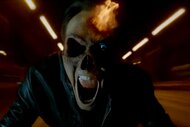Create a free profile to get unlimited access to exclusive videos, sweepstakes, and more!
Revisiting Louise Simonson's run on X-Men

Louise Simonson's famous first appearance in a comic was as the model for Linda Olsen Ridge, Alec Holland's (otherwise known as the Swamp Thing) wife in House of Secrets #92. A few years later, Simonson was editing for the legendary horror publisher Warren, overseeing classics like Vampirella and the anthologies Creepy and Eerie.
It was during her time at Warren that she began dating Walter Simonson, who would eventually become her second husband. The two remain one of comics' most iconic power couples to this day, even appearing together for a cameo in 2011's Thor. Yet Louise Simonson's works are sometimes overlooked, despite her truly iconic work on Marvel's X-Men franchise during its original explosion in popularity. She deserves more recognition than what she gets, so we're looking back on her help defining the X-Teams we know and love.
1980 turned out to be a pretty big year for Simonson, who began working at Marvel Comics on what we now regard as one of their most important titles during its most crucial development phase. Simonson's first credit editing on Uncanny X-Men appears in Issue #137, the conclusion of The Dark Phoenix Saga. Today, Dark Phoenix is considered to be the greatest X-Men story of all time, so this is about as high-profile a debut as one could have. Simonson continued editing the book until #182, when the job was passed on to the equally rad and underrated Ann Nocenti.
Simonson chose to pursue freelance writing at Marvel after her editing work had run its course and created the Power Pack, one of Marvel's more interesting concepts of the mid-'80s. The intersection between childhood innocence and adult themes made for a more complex story than the series is usually given credit for. It was this very specific vibe that Simonson brought to her first full-time X-book: X-Factor.
The introduction of X-Factor is generally considered a bit of a debacle. The concept of bringing back the original five X-Men for a team was conflicting due to the death of Jean Grey in Uncanny X-Men #137. Having caused the genocide of an entire planet, Jean couldn't come back without repercussions. It was decided that Jean was actually in a cocoon at the bottom of Jamaica Bay during the events of the Phoenix Saga and that the Phoenix had simply impersonated her. When Cyclops found out, he abandoned his wife Madelyne and his son Nathan to be with Jean. Meanwhile, the manager and financial backing for the team, Cameron Hodge, was manipulating the team to his own nefarious ends.
It was this incredibly convoluted jumping-on spot that Simonson turned into comics gold, writing X-Factor from Issues #6 through 64, one of the notably lengthy runs of the '80s. Simonson smoothed out some of the less cohesive parts of the concept, such as the team's mostly incomprehensible status as "mutant revolutionaries in disguise as mutant hunters." Under her pen, the original five X-Men went from complete emotional disaster to forming tighter bonds than ever. Cyclops and Jean Grey work through their complex issues with one another, and it's messy and not always pleasant to read. Warren Worthington's longstanding feelings of insecurity flare up and go awry as he has his wings ripped out, attempts death by suicide, is brainwashed by Apocalypse (who Simonson created), and eventually becomes Archangel. Beast and Iceman's friendship is challenged, and the team is robbed of the things that they hold most definitive of their characters — Warren's flight, Jean's sense of self, Cyclops' leadership, Iceman's humor, Beast's intelligence — and they still regroup and come back stronger than ever.
Next, Simonson became the writer of The New Mutants with #56. Though her run is somewhat polarizing among fans, it certainly rejuvenated the series after it had seemingly lost its way while creator Chris Claremont struggled with the workload of starting new X-Men spin-offs. Simonson doesn't immediately click with the characters, but when she does, the series gets very good in a very short time. Though this time period includes some of the strangest New Mutants story arcs and characters, it also merged the team with several new, interesting, and challenging mutants who did not have the luxury of coming of age on the grounds of the Xavier Institute.
Though Simonson's returns to the X-Franchise have been sparse, she did write a criminally underrated romp based around the former New Mutant Warlock in 1999. Though the series came out toward the very beginning of widespread internet use, the tech remains surprisingly interesting. Perhaps most importantly, it's the heartfelt attempts by an outsider to truly belong somewhere that mark so many Simonson stories that come through clear as crystal. She also briefly returned for X-Factor Forever, which was a true gem of a miniseries that hit all the nostalgia buttons while updating the concepts and the tone of the characters in a way that many great creators returning to books after decade-long absences have fumbled.
After Simonson's work at Marvel came to an unceremonious end with the new wave of young talent at the company and the end of the Claremont era, she enjoyed lengthy success at DC through their Superman titles, creating the character Steel and taking part in the Death of Superman story. Though we don't see much of her work these days, there's no denying that Simonson is a comic book legend. Her contributions through some of the lesser-known periods of certain X-Men titles not only age surprisingly well but helped bring her trademark empathetic but hopeful storytelling to books that could have easily been bogged down by hubris.




























